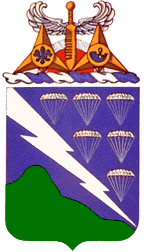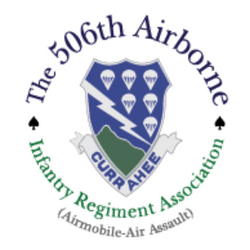hIstory
Library/History
This section provides current and historical information about the Association, the 506th Infantry Regiment and its successor and attached units, and those who have served with distinction, most importantly those Currahee recipients of the Medal of Honor and Distinguished Service Cross. Please feel free to browse these documents. Current publications are available to Members, while all other historical information is available to all users.
The 506th Airborne Infantry Regiment Association (Airmobile-Air Assault) (“the Association”) retains all rights associated with all materials created by or for use on this website under the provisions of the Berne Convention of 1989.
All submissions of corrections or additional information are encouraged and should be submitted to the hq@506infantry.org.
Insignia
The distinctive insignia is the Regiment Motto and the Shield from the Coat of Arms.
Currahee Mountain represents the foundation of the 506th's training. It was on this tough, rugged little mountain at Toccoa, GA, that the men of the 506th were sufficiently hardened to enable them to break the world forced march record of 115 miles held by the Japanese Army. The 506th gained nationwide attention for this feat. "Currahee" ( which is the American aboriginal Cherokee Indian equivalent for "Stands Alone") was the cry of the 506th paratroopers as they cleared the door on their first jump, and it continued to be their cry when in combat.
The Distinctive Insignia of the 506th Infantry Regiment was approved by the US Army on December 27, 1951.
Coat of Arms
Motto: Currahee (Stands Alone) 
Symbolism: The blue field of the Shield is for the Infantry, the 506th's arm of service. The thunderbolt indicates the regiment's particular threat and technique of attack: striking with speed, power, and surprise from the sky. Six parachutes represent the fact that the 506th was the sixth parachute regiment constituted in the U.S. Army. The green silhouette represents Currahee Mountain--the site of the regiment's activation (Camp Toccoa, GA)--and symbolizes the organization's strength, independence, and ability to stand alone for which paratroops are renowned. In fact Currahee is the American aboriginal Cherokee Indian equivalent for "Stands Alone."
In the Crest, the winged sword-breaker represents AIRBORNE troops. The conjoined caltraps stand for the enemy line of defense behind which paratroopers are dropped. They are two in number in reference to the unit's two air assault landings. The fleur-de-lis is for the Normandy invasion, and the bugle horn from the arms of Eindhoven, Holland, refers to the organization's capture of that objective. The spikes of the caltraps stand for the unit's World War II decorations. The demi-roundel represents a section of the hub of a wheel. It stands for Bastogne, Belgium, strategic crossroads of highways and railways. The hub, surmounted by the winged sword-breaker, commemorates the organization's heroic defense of Bastogne in the Battle of the Bulge.
Currahee Mountain further represents the foundation of the 506th's training. It was on this tough, rugged little mountain that the men of the 506th were sufficiently hardened to enable them to break the world forced march record of 115 miles held by the Japanese Army. The 506th gained nationwide attention for this feat. "Currahee" was the cry of the 506th paratroopers as they cleared the door on their first jump, and it continued to be their cry when in combat.
The Coat of Arms of the 506th Infantry Regiment was approved by the US Army on December 27, 1951.

